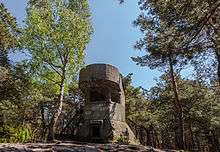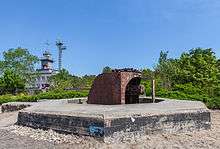Hel Fortified Area
The Hel Fortified Area (Polish: Rejon Umocniony Hel) was a set of Polish fortifications, constructed on the Hel Peninsula in northern Poland, in close proximity to the interwar border of Poland and the Third Reich. It was created in 1936, upon a decree of President Ignacy Moscicki.[1] It covered most part of the peninsula, and during Polish September Campaign, it was the last place of Poland to surrender to the invading Wehrmacht[2] (for more information, see Battle of Hel). During World War II, the naval base in Hel was used as a major training facility for U-boat crews.[3]
History



After Poland regained independence in the fall of 1918 (see: Partitions of Poland), and the symbolic wedding ceremony with the Baltic Sea by units of the Polish Army under General Józef Haller de Hallenburg (Puck, February 10, 1920), Polish military authorities began preparations of a fortified army garrison along the coast. As early as July 22, 1920 General Kazimierz Sosnkowski ordered construction of a strategic rail line which ran from Puck, through Wladyslawowo, to Hel. The line was completed in 1921, together with telegraph connection, by the logistics units of the Polish Army.[4] A road was constructed along the line.
In 1931, Polish Army began the construction of the naval base in Hel. At the same time, the tip of the peninsula, from Jurata to Hel, was placed under military administration. Construction of new houses and tourist facilities was forbidden, movement of civilians was strictly limited. These regulations were strengthened by the decree of President Ignacy Moscicki, signed on August 21, 1936, which officially created the Hel Fortified Area.
Soon afterwards large-scale works began. A network of rail connections, mostly narrow-gauge, was built, together with concrete-strengthened artillery positions. Armaments and military equipment were brought. The Army started modernization of the naval base at Hel. The base, designed by Wlodzimierz Szawernowski, had been built in 1931, by a Polish-French Enterprise in a location known as Stary Hel (Old Hel). An underground power plant was placed some 1.5 kilometers north of the port, also in adjacent forests, shelters for ammunition, mines and torpedoes were built. An underground petroleum storage reservoir was constructed, with a pipeline to the port. Even though the Hel Fortified Area was not officially created until 1936, Polish Army had been purchasing equipment for it earlier. In July 1935, four Swedish-made Bofors guns (152 mm) were bought and brought to Gdynia aboard transport ship ORP Wilia. Transported to Hel by train, the guns were mounted in October 1935.[5]

World War II and postwar
The battle of Hel was one of the longest battles of the Polish September Campaign. Units of the Wehrmacht approached the peninsula on September 9, 1939. Hel, manned by some 2000 Polish soldiers, was the longest-defended pocket of the Polish Army during the whole campaign.[6] Cut off from the mainland on September 14, and shelled with 280 millimeter guns, it surrendered on October 1, 1939, after a fierce defense, during which many German planes were shot down.[7] Some sources, such as Dictionary of Battles and Sieges, put the date of surrender on October 2, 1939.[6]
During the German occupation of Poland, Hel, reverting to its German name of Hela, was a major training facility of the U-boat crews.[8] Almost immediately after cessation of hostilities, the Germans began further construction work on the base. Among others, the Schleswig-Holstein battery was built for three 40.6 cm SK C/34 guns ("Adolf guns"). These guns fired shells of up to 1030 kilograms, and their range was up to 56 kilometers. Toward the end of the war, the Germans began construction of an airfield, but it was never completed. The Wehrmacht also installed Würzburg-Riese radar stations, as Hela was supposed to defend the main naval port of Gdynia, renamed Gotenhafen. On the night of April 3–4, 1945, the Germans carried out Operation Walpurgisnacht, during which thousands of soldiers and refugees were transported from Gdynia to Hela. The German soldiers on the peninsula repelled several Soviet attacks and surrendered on May 14, 1945, six days after Germany had capitulated.[9]
In the People's Republic of Poland, Hel did not lose its strategic importance. The peninsula was among the most protected military bases of the country. The base was rebuilt and strengthened, with Soviet-made guns of 130mm. As time went on, new military doctrine reduced the value of coastal artillery. Because of that, all coastal batteries in Poland were decommissioned. Everything that remained was in 1999 designated as military monuments.
Currently
Entry to some areas of the Hel Fortified Area is restricted by the military, but most places are open to tourists. Among the most notable monuments are:
- Laskowski battery number 1 (1935), where in late 1930s, four Bofors 152 mm guns were placed. In 1948, the battery was redone, its name was changed to 13 BAS, and Soviet-made B-13 130 mm naval guns were mounted. One of these guns can still be seen,
- battery number 21 (1935), where 2 Schneider 75 mm guns were placed,
- post of four Soviet-made B-34U 100 mm guns (1955), with one of them still located there,
- six posts of the Schleswig-Holstein battery. They were built by the Germans in 1940. Made of reinforced concrete, they displayed 40,6 centimeter guns SK C/34 “Adolf”. Together with posts, bunkers, observation tower, and magazines for ammunition were built,
- battery number 31 - located at the headland,
- battery number 32 (“Greek”) (originally two field guns Schneider 105 mm), in mid-distance from Hel to Jurata,
- battery number 33 (“Danish”) (originally two field guns Schneider 105 mm), at northern tip of the town of Hel,

- battery number 41, west of Jastarnia, aimed at the Gdańsk Bay,
- battery number 42, east of Jastarnia, aimed at the Baltic Sea,
- battery number 43, near the port of Władysławowo, on September 8, 1939, moved to Chałupy,
- in Jastarnia, there are four bunkers of the main Polish line of land defence. These bunkers are named Sokół, Sabała, Saragossa, and Sęp.[10]
All fortifications of Hel were in 1999 added to the Polish military monuments register.
See also
References
- ↑ Polityka weekly, Cel: Hel, article by Ryszarda Socha, published March 15, 2007
- ↑ Poland By Neal Bedford, Steve Fallon, Neil Wilson, page 433 “Hel was the last place of Poland to surrender”
- ↑ Naval strategy and operations in narrow seas by Milan N. Vego, page 62 “...where in the area of the Hel Peninsula and Libau were concentrated 50-60 per cent of all German U-boat training facilities
- ↑ Hel online, History of Hel
- ↑ Polish Army 1918-1939. 31 bateria artylerii nabrzeżnej im. Heliodora Laskowskiego
- 1 2 Dictionary of Battles and Sieges: F-O By Tony Jaques, page 441
- ↑ Henry Steele Commager, The Story of the Second World War, Brassey's, 2003, page 20
- ↑ Naval strategy and operations in narrow seas, page 62
- ↑ Hel as a defensive fortress of Polish Seashore
- ↑ Polish Army 1918-1939, Hel Fortified Area
External links
Coordinates: 54°37′N 18°47′E / 54.617°N 18.783°E